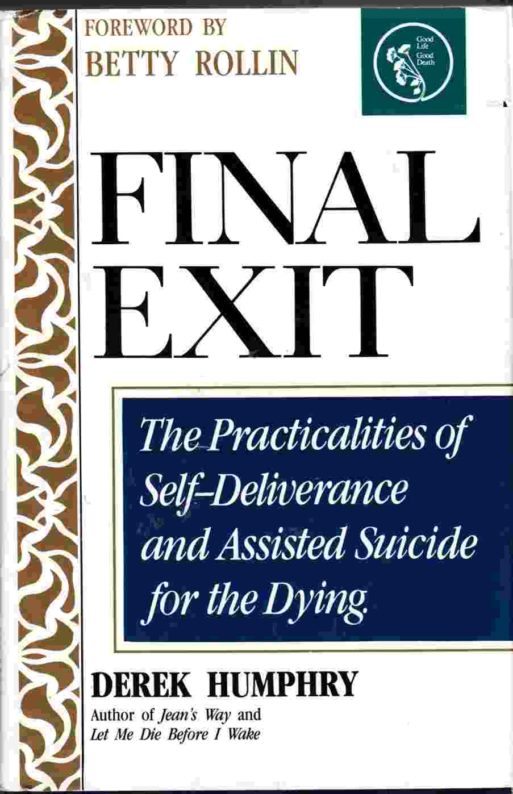 As a guide, Final Exit by Derek Humphry blends many styles of writing to advise terminally ill people who want to die with dignity and those who support and take care of them. Final Exit is part instruction manual, part memoir. As the founder of the Hemlock Society, Derek Humphry often writes what seems like propaganda.
As a guide, Final Exit by Derek Humphry blends many styles of writing to advise terminally ill people who want to die with dignity and those who support and take care of them. Final Exit is part instruction manual, part memoir. As the founder of the Hemlock Society, Derek Humphry often writes what seems like propaganda.
The book is divided into two parts. The first part informs readers on a wide range of topics such making the decision to die with dignity, knowing when to do so, choosing the right doctors and considering whether or not loved ones should know about or be involved in the process. The first section also provides both famous and personal anecdotes to illustrate methods of self-deliverance and their success. In one chapter, Humphry intertwines the concept of the will to die with the idea of “miracle cures” whch some terminally ill people choose to believe. Although he shares his own skepticism about “miracle cures,” Humphry conveys his respect for people to make their own choices by beautifully saying, “Yet despite all the medical treatment in the world, death will come to us all. It is up to the judgment of each individual to determine when medical treatment should be discontinued or life brought to an end.” This section ends with a checklist, along with a drug dosage table, for individuals making the final decisions to end their lives with dignity.
The second section is geared more towards terminally ill patients fortunate enough to have doctors willing to risk their careers to help them die with dignity. Assisted self-deliverance is still a very taboo topic in the United States. Since Final Exit’s publication in 1990, only three states (Oregon, Washington, Vermont) have enacted Death with Dignity Acts. Therefore, many terminally ill people face insurmountable obstacles in finding doctors who supportive of their wishes for self-deliverance. Aside from one chapter that details the Kevorkian saga, the section mainly delves into reasons for justifiable assisted self-deliverance and reviews the methods that should or should not be used by doctors.
Personally, this book informed me about topics I was not as familiar with before reading it. The cultural and historical tidbits, as well as the anecdotes, kept me entertained. However, the in-depth details about methods, guidelines for the process and information about drug dosages and use would most likely suit patients, loved ones or physicians rather than laypeople with little medical background.
More SevenPonds Reviews:

 ”Final Exit: The Practicalities of Self-Deliverance and Assisted Suicide for the Dying.” by Derek Humphry
”Final Exit: The Practicalities of Self-Deliverance and Assisted Suicide for the Dying.” by Derek Humphry



 The Other Death in the Family
The Other Death in the Family

 The Healing Sound of Singing Bowls
The Healing Sound of Singing Bowls














